Translators & Language
Professionals
Subject-Area Dictionaries from
Elsevier Group:
Medicine, Science &Technology
Astronomy, Biology, Chemistry,
Engineering, Genetics,
Internet, Mecicine, Physics, Science, Psychiatry, Zoology
IMPORTANT NOTICE:
All prices are subject
to change. The prices listed here are for reference only and were the
publisher's suggested retail price at the time we posted this catalogue.
Usually, LEA Book Distributors will charge the publisher's suggested US retail
price or at times the publisher's price for foreign customers. Check with us for
latest price changes.
TO ORDER:
Just send an e-mail with your
list, full address, and credit card data. Institutions: Send P.O. orders@leabooks.com
We offer these
outstanding choices:
NEW!: 2003 Elsevier's
Dictionary of
Acronyms, Initialisms, Abbreviations and Symbols
(in
Science, Technology, & Medicine)
Second, Revised and Enlarged Edition
Elsevier's
Dictionary of
Abbreviations, Acronyms, Synonyms and Symbols
used in Medicine
In English (with definitions)
Elsevier's
Dictionary of
Biology
In English (with definitions)
Experimental
Design
A Handbook and
Dictionary for Medical and Behavioral
Research
Elsevier's
Dictionary of
Fisheries
In English (with definitions)
NEW!:
2004 Elsevier's
Dictionary of
Foresty
Elsevier's
Dictionary of the
Genera of Life
In English (with definitions)
Dictionary
of
Infectious Diseases
(Print + CD-ROM)
Elsevier's
Encyclopedic Dictionary of
Measures
In English (with definitions)
Elsevier's
Medical Terminology for the Practicing Nurse
In English (with definitions)
A
Dictionary of
Pharmacology
and Allied Topics
Second Edition
Elsevier's
Dictionary of
Plant Genetic Resources
In English (with definitions)
Elsevier's
Dictionary of
Plant Names
and their Origin
In English (with definitions)
NEW!: 2003
Elsevier's
Dictionary of Acronyms, Initialisms, Abbreviations and Symbols
(in Science, Technology, & Medicine)
Second, Revised and Enlarged Edition
- F. Benedetto Mattia, Milan, Italy
The dictionary will contain an alphabetical listing of approximately 30,000
(thirty thousand) acronyms, initialisms, abbreviations and symbols covering
approximately 2,000 fields and subfields ranging from Pelagic Ecology to Anthrax
Disease, Artificial Organs to Alternative Cancer Therapies, Age-related
Disorders to Auditory Brainstem Implants, Educational Web Sites to Biodefense,
Biomedical Gerontology to Brain Development,Cochlear Implants to Cellular
Phones, Constructed Viruses to Copper Metabolism, Drug Discovery Programs to
Drug-resistant Strains, Eugenics to Epigenetics, Epilepsy Drugs to Fertility
Research, Genetically Modified Foods/Crops to Futuristic Cars, Genetic Therapies
to Glycobiology, Herbicide-tolerant Crops to Heritable Disorders, Human
Chronobiology to Human gene Therapies, Immunization Programs to Lunar Research,
Liver Transplantation to Microchip Technology, Mitochondrial Aging to Molecular
Gerontology, Neurodegenerative Diseases to Neuropsychology of Aging,
Neurosurgery to Next Generation Programs, Obesity Research to Prion Diseases,
Quantum Cryptography to Reemerging Diseases, Retinal Degeneration to Rice Genome
Research,Social Anthropology to Software Development, Synchrotron Research to
Vaccine Developments, Remote Ultrasound Diagnostics to Water Protection,
Entomology to Chemical Terrorism and hundreds of others, as well as
abbreviations/acronyms/initialisms relating to European Community and U.S.,
Japanese and International Programs/Projects/Initiatives from year 2000 up to
2010 as well as World Bank Programs.
Year 2003
- ISBN: 0-444-51241-1
- Hardbound, 700 pages #
- In preparation
- approx. 30,000 terms
Elsevier's
Dictionary of Abbreviations, Acronyms, Synonyms and Symbols used in Medicine
In English (with definitions)
- S.A. Tsur, Akko, Israel
A vast amount of information, including abbreviations of medical terms used
in the field of anatomy, bacteriology, biology, chemistry, medicine (human and
veterinary), pathology, pharmacology, etc., has been meticulously catalogued
since work on the project started in 1979 from medical journals, scientific
dictionaries and encyclopedias, and compilations of medical abbreviations
published in the US and other countries. Over 20,000 entries have been included,
with especially detailed itemization of the chemical elements, hormones,
insulins, kidney function tests, pulmonary function tests, serological tests for
syphilis, symbols used in various disciplines, such as biology, calculation,
chemistry, Greek alphabet, medicine and pharmacy, numeration and signs of the
zodiac, the vitamins , etc. Besides these, under their respective headings
different names, scientific and otherwise, have been catalogued for drugs such
as amphetamine, cocaine, heroin, lysergic acid, marijuana, opium etc.
Year 1999
- ISBN: 0-444-82904-0
- Hardbound, 646 pages #
- approx. 20,000 terms
- Price:
Elsevier's
Dictionary of Biology
In English (with definitions)
- R. Tirri
J. Lehtonen
R. Lemmetyinen
S. Pihakaski
P. Portin, University of Turku, Department of Biology, Turku, Finland
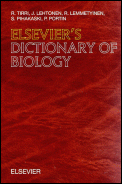 Biology is an extensive subject that has undergone a vast expansion and so
comprises not only such conventional aspects as taxonomy, morphology,
biochemistry, functional physiology, and ecology, but also the rapidly expanding
new fields of cell biology and molecular biology. This dictionary attempts to
provide a comprehensive coverage of biological terms, recognising also that the
interface between biology and other sciences, such as chemistry and physics as
well as medicine, is becoming less distinct and includes terms from these other
areas.
Biology is an extensive subject that has undergone a vast expansion and so
comprises not only such conventional aspects as taxonomy, morphology,
biochemistry, functional physiology, and ecology, but also the rapidly expanding
new fields of cell biology and molecular biology. This dictionary attempts to
provide a comprehensive coverage of biological terms, recognising also that the
interface between biology and other sciences, such as chemistry and physics as
well as medicine, is becoming less distinct and includes terms from these other
areas.
This book is intended especially for teachers and students
of biology and other natural sciences, environmental sciences and medicine.
College students, amateur biologists, journalists, translators and civil service
officers will also find this a useful tool.
- International Journal for Language & Documentation
- "...the best aspect of the book is the succinct but clear
explanations of every term."
- E-STREAMS
- "...This is a must purchase for academic and special or
personal collections in the biological and medical research fields. It,
also, would be suitable for large public libraries and for upper level high
school student use. "
- Translatio-Nouvelles de la Fit
- "...Elsevier's Dictionary sets out to give an answer to the
terminology problems within the very largely extended subject of biology. As
such, it will prove to be useful not only to students and their teachers of
biology, but also to other people who regularly deal with biology related
texts. Translators, amateur biologists, journalists, biologists in industry
and the administrators of biological programmes, for example, will
undoubtedly find the dictionary a useful tool as well. "
Year 1998 1st reprint 2000
- ISBN: 0-444-82525-8
- Hardbound, 768 pages #
- 1st reprint 2000
- About 10,000 terms
- Price:
Experimental
Design
A Handbook and Dictionary for Medical and Behavioral
Research
- J. Krauth, Heinrich-Heine-Universität Düsseldorf, Psychologisches
Institut, Lehrstuhl IV, Universitätsstrasse 1, D-40225 Düsseldorf, Germany
Included
in series: Techniques in the Behavioral and Neural Sciences, 14
-
 Scientists planning experiments in medical and behavioral research will find
this handbook and dictionary an invaluable desk reference tool. Also
recommended as a textbook for students of Experimental Design or
accompanying courses in Statistics.
Scientists planning experiments in medical and behavioral research will find
this handbook and dictionary an invaluable desk reference tool. Also
recommended as a textbook for students of Experimental Design or
accompanying courses in Statistics.
Principles of experimental design are introduced, techniques of experimental
design are described, and advantages and disadvantages of often used designs
are discussed.
This two-part volume, a handbook of experimental design and a dictionary
providing short explanations for many terms related to experimental design,
contains information that will not quickly become outdated.
A. Handbook of Experimental Design.
1. Historical remarks.
2. The object of experimental design.
3. A case for experimental design.
4. Control of extraneous variables.
5. Preliminary experiments and pilot studies.
6. Designs which had better be avoided.
7. Designs without repeated measures.
8. Designs with repeated measures.
9. Single-case experimental designs.
Answers to the Questions (with References).
B. Dictionary of Experimental Design.
References;
Author Index;
Subject Index.
Year 2000 Hardbound , Paperback
- ISBN: 0-444-50637-3
- Hardbound, 296 pages #
- Price:
- ISBN: 0-444-50638-1
- Paperback, 296 pages
- Price:
Elsevier's
Dictionary of Fisheries
In English (with definitions)
- P.K. Eapen, Cochin, India
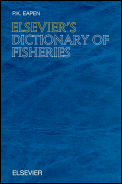 Elsevier's
Dictionary of Fisheries contains a large number of technical terms in
fisheries, their respective meanings and explanations in a concise and simple
manner. Like an ocean, the subject fisheries too, is vast and multi-disciplined.
The terms have been selected to represent most of these disciplines.
Elsevier's
Dictionary of Fisheries contains a large number of technical terms in
fisheries, their respective meanings and explanations in a concise and simple
manner. Like an ocean, the subject fisheries too, is vast and multi-disciplined.
The terms have been selected to represent most of these disciplines.
The dictionary contains terms covering the following fields and subfields:
Marine biology, Limnology, Ecology, Pathology, Oceanography, Meteorology,
Aquaculture, Fishing gear and gear materials, Fishing methods, Fish processing
and products, Processing machines, Microbiology, Quality control, Fishing boats
and equipment, Navigation, Law of the sea, Fisheries statistics. Only those
terms which are frequently used, or which are thought to be helpful to different
kinds of users are included.
- Translatio-Nouvelles de la Fit.
- "...With the wide range of fisheries-related fields included
and the mostly clear explanations in English, the dictionary can be a very
useful tool for many different target groups, ranging from beginning
students to experienced specialists. "
- Bundesverband der Dolmetscher und Übersetzer
- "...Alles in allem liegt hier ein Nachschlagewerk vor, an dem
auf diesem Gebiet tätige Dolmetscher und Übersetzer nicht vorbei kommen,
auch wenn es "nur" rein englischsprachig ist. Es gibt kein anderes
Buch, in dem man eine solch enorme Zahl von wohl ausgewählten Fachwörtern
und ähnliche Informationen nachschlagen kann. "
- Fishing Boat World
- "...A valuable addition to international fishing
knowledge."
- Die Muehle and Mischfuttertechnik
- "...ist das Wörterbuch der Fischerei ein wertvolles Instrument
für Praxis, Forschung und Lehre."
Year 1999
- ISBN: 0-444-50308-0
- Hardbound, 350 pages #
- 7,050 terms
- Price:
NEW!: in 2004
Elsevier's
Dictionary of Foresty
- B. Delijska
The dictionary will contain terms used today in forest science, management
and conservation, comprising forest ecology, forest entomology and pathology,
forest fire management, forest geomatics, forest meteorology and hydrology,
forest soils and geomorphology, forest surveys and mensuration, genetics and
tree improvement, harvesting and forest operations, integrated forest
management, photogrammetry and remote sensing, physico-mechanical properties of
wood, processing (panels, pulp and paper, sawing, etc.), silviculture, tree
physiology, agroforestry, urban forestry, wildlife and wilderness management and
arboriculture, wood anatomy and structure.
Year 2004
- ISBN: 0-444-51245-4
-
Hardbound, approx. 900 pages
- In preparation
- approx. 10,000 terms
Elsevier's
Dictionary of the Genera of Life
In English (with definitions)
- S.A. Tsur, Akko (Acre), Israel
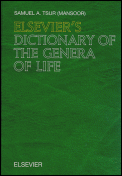 This dictionary is the alphabetical compilation of most of the recognized genera
of life, as we know it on earth, of the animal and vegetable kingdoms. The Latin
names of more than 5,280 animals and plants, bacteria, fungi and other parasitic
forms of existence are listed, together with at least one example of their
respective species.
This dictionary is the alphabetical compilation of most of the recognized genera
of life, as we know it on earth, of the animal and vegetable kingdoms. The Latin
names of more than 5,280 animals and plants, bacteria, fungi and other parasitic
forms of existence are listed, together with at least one example of their
respective species.
An index of the more common or lay names of the various genera has also been
catalogued, enabling the reader to arrive promptly at the scientific/Latin name
of the particular genus.
- The NHBS Catalogue
- "...Includes more than 5,280 genera, making this book one of
the most comprehensive compilations of its type ever published. ... A
valuable reference for botanists and zoologists."
Year 1999
- ISBN: 0-444-82905-9
- Hardbound, 564 pages #
- approx. 5,300 terms
- Price:
Dictionary
of Infectious Diseases
- D. Raoult, Faculty of Medicine, Marseilles, France
R. Tilton, North American Laboratory Group Ltd., USA
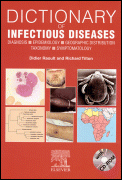 Truly a collective work, the Dictionary of Infectious Diseases is an
indispensable aid for clinicians, epidemiologists, teachers and scientists. The
CD-ROM version includes more than one thousand original color photographs, and
the printed version contains a vast amount of information providing quick and
simple answers to clinicians' everyday questions.
Truly a collective work, the Dictionary of Infectious Diseases is an
indispensable aid for clinicians, epidemiologists, teachers and scientists. The
CD-ROM version includes more than one thousand original color photographs, and
the printed version contains a vast amount of information providing quick and
simple answers to clinicians' everyday questions.
Edited by Prof. Richard Tilton, Editor-in-Chief of the
Journal of Clinical Microbiology and former Director of the Clinical
Microbiology Division at the University of Connecticut, and Prof. Didier Raoult,
professor of microbiology at the Faculty of Medicine in Marseilles (France),
specialist in intracellular bacterial infections, this dictionary features both
clinical syndromes and descriptions of specific microorganisms, including
emerging infectious diseases. Maps, phylogenic trees and tables enable the
reader to quickly visualize risk factors and sources of contamination. Students
and educators will also find useful descriptions of laboratory techniques for
identifying pathogens.
A huge amount of information which is rapidly accessible through
cross-referencing by key words in the book, and numerous hypertext links in the
CD-ROM make this dictionary a precious tool for physicians, biologists and
students for updating and enriching their knowledge of the field.
Audience:
Specialists in infectious diseases, Virologists, Bacteriologists,
Epidemiologists, Medical Teachers and Students.
Year 1999
Set of print + CD-ROM
- ISBN: 2-84299-146-X
- 1126 pages
- Hardbound + CD-ROM
- Price:
Elsevier's
Encyclopedic Dictionary of Measures
In English (with definitions)
- D. Fenna, Zystematica Inc., 51055 Range Road 204, Sherwood Park,
Alberta, Canada T8G 1E5
This dictionary addresses the myriad units of measurement that have arisen
through the ages, from classical weights etc., to the latest scientific units -
all addressed in historical terms, across cultures as appropriate. Most of the
4000 terms are basic in content, with just the information required to convey
role and size (in metric and US units), but relationships between units are
shown fully, and many entries give encyclopedic exposition of the historical
development and usage of units. Such articles add considerable readability to
what is essentially a comprehensive master reference work serving the
humanities, science and general interests.
Each entry consists of a headword, the broad purpose (measurement realm or
functional context), the country or other area of use, the description and
definition, and, where appropriate, etymological and translational notes and
synonyms of the headword.
The dictionary is of special interest to researchers, teachers and
translators in the humanities and science, people involved in international
trade, investment, travel and news reporting, engineers and engineering students
as well anyone interested in understanding the many facets of measurement
involved in everyday life.
- International Journal for Language and Documentation
- "This book is endlessly fascinating; I genuinely could not put
it down. There are some 4,000 terms covering all languages and cultures, all
fully explained. ... The sheer comprehensiveness of the work is
astonishing,... the explanations are packed with information, ... "
- E-STREAMS
- "...the coverage in general is excellent. ...the truly global
coverage of measures is unprecedented and quite useful. ...a recommended
book for all university libraries."
Year 1998
- ISBN: 0-444-50046-4
- Hardbound, 606 pages #
- About 4,000 terms
- Price:
Elsevier's
Medical Terminology for the Practicing Nurse
In English (with definitions)
- S.F. Vanderwerf, Temple, TX, USA
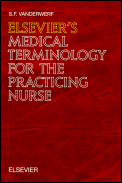 Medical
nomenclature is continually evolving and changing. Its objective is to achieve
full scientific interaction among all those who share this discipline. In the
course of their work, professional nurses are required to comprehend and
interpret medical terminology. This dictionary presents a correlation of medical
and nursing terms as reflected in medical practice and nursing arts. Also
included, is a survey of little-used and/or newer terminology which more
articulately documents clinical findings. Readers of this dictionary will be
encouraged to embrace medical terminology as a career-long discipline with a
purpose.
Medical
nomenclature is continually evolving and changing. Its objective is to achieve
full scientific interaction among all those who share this discipline. In the
course of their work, professional nurses are required to comprehend and
interpret medical terminology. This dictionary presents a correlation of medical
and nursing terms as reflected in medical practice and nursing arts. Also
included, is a survey of little-used and/or newer terminology which more
articulately documents clinical findings. Readers of this dictionary will be
encouraged to embrace medical terminology as a career-long discipline with a
purpose.
Audience:
For professional/vocational nurses, the laity seeking medical information,
university faculties and students and teachers of all levels and subjects.
Year 1998
A
Dictionary of Pharmacology and Allied Topics
Second Edition
- D.R. Laurence, London, UK
J.R. Carpenter, Derbyshire via Stockport, UK
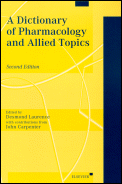 This
dictionary spans the practice of pharmacology, and of allied sciences insofar as
they are related to it, with particular emphasis on the development, regulation
and use of human medicine. It is offered to students as well as to professionals
in pharmacology and allied sciences for reference and for browsing,
and as a bedside book and travelling companion. Its size (approximately 2000
entries) is appropriate for these uses.
This
dictionary spans the practice of pharmacology, and of allied sciences insofar as
they are related to it, with particular emphasis on the development, regulation
and use of human medicine. It is offered to students as well as to professionals
in pharmacology and allied sciences for reference and for browsing,
and as a bedside book and travelling companion. Its size (approximately 2000
entries) is appropriate for these uses.
Features of this dictionary:
 Provides definitions of terms in
pharmacology, both basic and clinical
Provides definitions of terms in
pharmacology, both basic and clinical
 Gives information on new medicine
development and official regulations
Gives information on new medicine
development and official regulations
 Covers allied topics, including
statistics, ethics, scientific miscounduct, authorship, publication and law.
Covers allied topics, including
statistics, ethics, scientific miscounduct, authorship, publication and law.
- The International Journal of Risk and Safety, Prof. Graham Dukes
- "A dictionary like this was long needed, particularly because
the meaning of most terms used in pharmacology (and a lot of other areas of
medicine) has evolved and experienced sufficient mutation to cause
misunderstanding.
...This is a magnificent book. Let us not say that it should be on every
bookshelf; it should be so intensively used by every scientist and writer in
this field that it never has time to on the bookshelf at all. "
- Trends in Pharmacological Sciences, Dr. Jeffrey K. Aronson
- "The book has a wide scope, encompassing terms in basic
pharmacology and toxicology, various aspects of clinical pharmacology and
drug use, some statistics and law, and a few other words thrown in for good
measure (chaos, euphemism, and jargon, to pick a few at anything but
random). Dip into it stochastically (q.v.) just before a tutorial and you
will find some topic or other to stimulate discussion. "
Year 1998 Hardbound , Paperback
- ISBN: 0-444-82591-6
- Hardbound, 386 pages #
- About 2,000 terms
- Price:
- ISBN: 0-444-50050-2
- Paperback
Price:
Elsevier's
Dictionary of Plant Genetic Resources
In English (with definitions)
- International Board for Plant Genetic Resources, Rome, Italy
Plant genetic resources is a rapidly expanding field of interest that is
becoming increasingly important as global warming affects the patterns of world
agriculture. Every country will have to consider more active breeding programmes
to develop new varieties of crop plants adapted to the changing conditions.
Plant genetic resources will provide the raw material for these breeding
activities.
This dictionary is in effect a glossary of the terms used in the field,
defining words drawn from the many, diverse areas of interest that plant genetic
resources involve, from plant taxonomy to molecular genetics. Over 1800
definitions are provided, all of which have been developed in consultation with
experts in the field, particularly the genetic resources units of the
international agricultural research centres of the Consultative Group on
International Agricultural Research. IBPGR is one of these centres.
Students, postgraduates and in particular the staff of national programmes in
plant genetic resources will be interested in the book, as well as the libraries
of connected institutions.
- American Reference Books Annual
- "... appropriate for libraries that hold materials pertinent to
agriculture, food and animal sciences, horticulture, molecular agencies, and
plant biochemistry and physiology."
Year 1991 1st reprint 1995
- ISBN: 0-444-88959-0
- Hardbound, 196 pages #
- 1st reprint 1995
- 1,800 terms
- Price:
Elsevier's
Dictionary of Plant Names and their Origin
In English (with definitions)
- D.C. Watts, Bath, UK
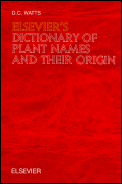 The dictionary will contain about 30,000 vernacular and literary English names
of plants (plus a few American), both wild and cultivated, with their botanical
name and a brief account of the names' meaning if known. It was conceived as
part of the author's wider interest in plant and tree lore, and ethnobotanical
studies.
The dictionary will contain about 30,000 vernacular and literary English names
of plants (plus a few American), both wild and cultivated, with their botanical
name and a brief account of the names' meaning if known. It was conceived as
part of the author's wider interest in plant and tree lore, and ethnobotanical
studies.
Knowledge of plant names can give insight into largely
forgotten beliefs. Why for example is, or was, the common red poppy known as
"Blind Man"? An old superstition has it that if the poppy were put to
the eyes it would cause blindness. Such names were probably the result of some
taboo against picking the plant. Similarly, other names were likely to have been
applied as a result of a country mother's warning to her children against eating
poisonous berries. For the warning carries more weight when the name given to
the berry reinforces the warning. Many such plants or fruits may be ascribed to
the devil, Devil's Berries for Deadly Nightshade is an example.
Names may also be purely descriptive, and can also serve to explain the
meaning of the botanical name. Beauty-Berry is an example: it is the name given
to the American shrub that belongs to the genus Callicarpa, which is made up of
two Greek words that mean beauty and berry.
Literary, or "book" names, have also been included in this
dictionary, as being a very important part of the whole. Many of them provide
links in the transmission of words through the ages. Thor's Beard, for example,
is a book name for "houseleek", and has never been used in the
dialect. But it highlights the legend that houseleek is a lightning plant, and
by reverse logic is a preserver from fire.
- Journal of Ethnopharmacology
- "...This dictionary contains about 30,000 vernacular and
British names of plants with the goal to summarise British 'plant and tree
lore'. ...The sheer size of the undertaking, but also that the book is such
a meticulous piece of scholarly work is very impressive and makes the book a
unique and very useful source of information on British plants. ...It is of
interest to anyone doing research on British plants, their history and
current use and to linguists and other scholars focusing on the British
language. "
Year 2000
- ISBN: 0-444-50356-0
- Hardbound, 1032 pages #
- approx. 30,000 terms
- Price:
Remember, we commit ourselves to provide...
ANY BOOK PUBLISHED IN ENGLISH
OR IN SPANISH!
|
LEA Book Distributors
170-23 83rd Avenue, Jamaica Hills, NY
11432, USA
Tel. 1(718)291-9891 * Fax 1(718)291-9830
Please direct all inquiries to: orders@leabooks.com
|
© LEA Book Distributors 1999
 Biology is an extensive subject that has undergone a vast expansion and so
comprises not only such conventional aspects as taxonomy, morphology,
biochemistry, functional physiology, and ecology, but also the rapidly expanding
new fields of cell biology and molecular biology. This dictionary attempts to
provide a comprehensive coverage of biological terms, recognising also that the
interface between biology and other sciences, such as chemistry and physics as
well as medicine, is becoming less distinct and includes terms from these other
areas.
Biology is an extensive subject that has undergone a vast expansion and so
comprises not only such conventional aspects as taxonomy, morphology,
biochemistry, functional physiology, and ecology, but also the rapidly expanding
new fields of cell biology and molecular biology. This dictionary attempts to
provide a comprehensive coverage of biological terms, recognising also that the
interface between biology and other sciences, such as chemistry and physics as
well as medicine, is becoming less distinct and includes terms from these other
areas.
 Scientists planning experiments in medical and behavioral research will find
this handbook and dictionary an invaluable desk reference tool. Also
recommended as a textbook for students of Experimental Design or
accompanying courses in Statistics.
Scientists planning experiments in medical and behavioral research will find
this handbook and dictionary an invaluable desk reference tool. Also
recommended as a textbook for students of Experimental Design or
accompanying courses in Statistics. Elsevier's
Dictionary of Fisheries contains a large number of technical terms in
fisheries, their respective meanings and explanations in a concise and simple
manner. Like an ocean, the subject fisheries too, is vast and multi-disciplined.
The terms have been selected to represent most of these disciplines.
Elsevier's
Dictionary of Fisheries contains a large number of technical terms in
fisheries, their respective meanings and explanations in a concise and simple
manner. Like an ocean, the subject fisheries too, is vast and multi-disciplined.
The terms have been selected to represent most of these disciplines.
 This dictionary is the alphabetical compilation of most of the recognized genera
of life, as we know it on earth, of the animal and vegetable kingdoms. The Latin
names of more than 5,280 animals and plants, bacteria, fungi and other parasitic
forms of existence are listed, together with at least one example of their
respective species.
This dictionary is the alphabetical compilation of most of the recognized genera
of life, as we know it on earth, of the animal and vegetable kingdoms. The Latin
names of more than 5,280 animals and plants, bacteria, fungi and other parasitic
forms of existence are listed, together with at least one example of their
respective species.
 Truly a collective work, the Dictionary of Infectious Diseases is an
indispensable aid for clinicians, epidemiologists, teachers and scientists. The
CD-ROM version includes more than one thousand original color photographs, and
the printed version contains a vast amount of information providing quick and
simple answers to clinicians' everyday questions.
Truly a collective work, the Dictionary of Infectious Diseases is an
indispensable aid for clinicians, epidemiologists, teachers and scientists. The
CD-ROM version includes more than one thousand original color photographs, and
the printed version contains a vast amount of information providing quick and
simple answers to clinicians' everyday questions.
 Medical
nomenclature is continually evolving and changing. Its objective is to achieve
full scientific interaction among all those who share this discipline. In the
course of their work, professional nurses are required to comprehend and
interpret medical terminology. This dictionary presents a correlation of medical
and nursing terms as reflected in medical practice and nursing arts. Also
included, is a survey of little-used and/or newer terminology which more
articulately documents clinical findings. Readers of this dictionary will be
encouraged to embrace medical terminology as a career-long discipline with a
purpose.
Medical
nomenclature is continually evolving and changing. Its objective is to achieve
full scientific interaction among all those who share this discipline. In the
course of their work, professional nurses are required to comprehend and
interpret medical terminology. This dictionary presents a correlation of medical
and nursing terms as reflected in medical practice and nursing arts. Also
included, is a survey of little-used and/or newer terminology which more
articulately documents clinical findings. Readers of this dictionary will be
encouraged to embrace medical terminology as a career-long discipline with a
purpose.
 This
dictionary spans the practice of pharmacology, and of allied sciences insofar as
they are related to it, with particular emphasis on the development, regulation
and use of human medicine. It is offered to students as well as to professionals
in pharmacology and allied sciences for reference and for browsing,
and as a bedside book and travelling companion. Its size (approximately 2000
entries) is appropriate for these uses.
This
dictionary spans the practice of pharmacology, and of allied sciences insofar as
they are related to it, with particular emphasis on the development, regulation
and use of human medicine. It is offered to students as well as to professionals
in pharmacology and allied sciences for reference and for browsing,
and as a bedside book and travelling companion. Its size (approximately 2000
entries) is appropriate for these uses.
 The dictionary will contain about 30,000 vernacular and literary English names
of plants (plus a few American), both wild and cultivated, with their botanical
name and a brief account of the names' meaning if known. It was conceived as
part of the author's wider interest in plant and tree lore, and ethnobotanical
studies.
The dictionary will contain about 30,000 vernacular and literary English names
of plants (plus a few American), both wild and cultivated, with their botanical
name and a brief account of the names' meaning if known. It was conceived as
part of the author's wider interest in plant and tree lore, and ethnobotanical
studies.